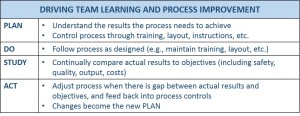Nobody argues with the value of learning. Most companies establish training budgets and hold classes on a variety of topics from leadership to lean. When the organization faces a drop in revenues, however, the training budget is one of the first areas facing cuts. Does this mean that leaders don’t believe in training, or is it that they don’t feel that the returns to the organization from training are worth the investment? I believe that it’s the latter. I also believe that they may be correct . . .
An Incorrect View of Learning
Since the start of my career, I’ve attended a number of internal and external training courses intended to improve my performance in one or more aspects of my job. Although some of what was taught in these classes was interesting, I’ve generally found that they rarely, if ever, drove permanent changes in my behavior or the quality of my work. Although it was nice to travel to places like New York City or San Francisco to attend classes, it was actually more of a perk than a true learning experience. What was interesting, though, is that when I became a leader, I sent people on my team to the same courses because that’s how training was done.
Only after I learned about the Plan-Do-Study-Act (PDSA) cycle did I start to question the traditional approach to training and development. Rather than taking place in a classroom, I came to realize that true and sustainable team learning happens by doing, and that it is driven by regular cycles of doing, reviewing, and renewing. Furthermore, since it happens real-time as part of the work people and teams are doing, it doesn’t necessarily need to be budgeted or scheduled. It does, however, need to be consciously applied as part of the PDSA cycle in order to assure that the learning and resulting improvement are sustained.
Team Learning
One big miss in the traditional approach to training and development is that it focuses on the individual more than the team. After all, teams produce results; not individuals. It really doesn’t matter how much an individual knows if he or she is unable to use the knowledge to drive improvement. Alternatively, the more a team learns and develops, the more sustainable the learning becomes. When one or more people leave, it becomes less of an issue because the knowledge gained stays with the team.
An example of the PDSA cycle driving team learning is listed in the table below. An important point about this concept is that learning implies action – and the cycle naturally leads to both. Without action, there is no learning because the team will never know the extent to which an idea actually makes things better.
Another aspect of team learning is the importance of a coach to guide the team’s efforts to understand and address problems. As a result, the team develops problem-solving skills as well as increased understanding of the processes in which they work.
LEADERSHIP DEVELOPMENT
Much like team learning, leadership development requires a clear understanding of results to clarify the gaps between actual and targeted performance. Since the focus of leadership performance is much more individualized than team performance, one-on-one coaching is critical to help the person understand the gaps and ideas for improvement more clearly.
The difference between coaching and the classroom for leadership development is that coaching occurs real-time in meetings and at gemba. A great place to coach a production supervisor, for example, is on the shop floor in front of her team’s dashboard. Reviewing the board to understand why certain metrics are being reported, how they are being used to drive improvement, how processes are actually operating, what the metrics are telling the team, and what they’re doing about the problems are all part of the conversation that can help develop the supervisor’s abilities to drive improvement. When done regularly, this type of conversation is far more effective than sending the supervisor to a one-week course on becoming a better leader.
IT COMES DOWN TO EXPECTATIONS
One thing that is rarely considered with an organization’s training strategy is the expectations. What do you want from the system? How will you know whether or not your training and development processes are delivering on expectations? Doing classroom training because that’s the way it’s always been done (like I did earlier in my career) is irresponsible leadership.
Assuming that sending someone to a training course will make him a better leader also shirks the responsibility of developing those on your team by delegating it to someone else. If you’re not able to do the coaching yourself, you have a gap that needs to be addressed to make you a better leader.
I believe that the major difference between traditional and lean methods of development is the idea that, under a lean mindset, learning implies action. A PDSA approach drives learning through doing . . . followed by reviewing and renewing. When applied in this way, learning becomes analogous to real improvement.








No comments:
Post a Comment